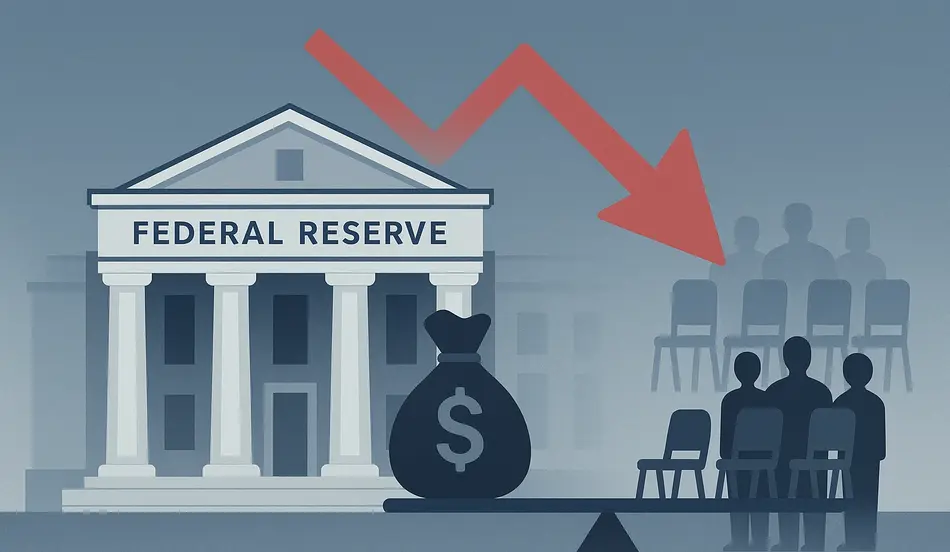Federal Reserve Chair Jerome Powell used his speech at the Jackson Hole Economic Symposium to deliver a significant shift in U.S. economic policy. After years of prioritizing the fight against inflation, Powell acknowledged that the labor market is weakening—and hinted that the central bank could cut interest rates as early as September 2025.
This pivot comes as employers reduce hiring plans, unemployment edges higher, and job creation falls far short of expectations. While some see this as a lifeline for a cooling economy, others warn that the move underscores how fragile the U.S. job market has become.
What Powell Said at Jackson Hole
In his address, Powell struck a tone that balanced caution with urgency. For much of the past two years, the Fed’s focus has been on curbing inflation, which surged during the pandemic recovery and trade disruptions. But with inflation cooling to near the Fed’s 2% target, Powell shifted his emphasis toward employment stability.
“Our dual mandate requires us to protect both price stability and maximum employment,” Powell told the audience. “With inflation cooling, we must also be mindful of labor market risks.”
Powell’s comments signal a policy pivot: the Fed is no longer only concerned about inflation overheating but is now equally focused on preventing a jobs downturn.
Weakness in the U.S. Job Market
The labor market data that shaped Powell’s comments paints a sobering picture:
- Payroll Growth Slows: In July, the U.S. added only 73,000 jobs, far below expectations.
- Revisions Add to Weakness: May and June job totals were revised down by a combined 258,000 positions.
- Unemployment at 4.2%: The rate has edged higher, hitting its highest point since early 2023.
- Jobless Claims Rising: Weekly claims hit 235,000 in mid-August, the highest in two months.
- Continuing Claims Up: Nearly 1.97 million Americans are on unemployment benefits—the most since November 2021.
This slowdown marks a sharp contrast to 2024, when average monthly job gains exceeded 160,000. Economists warn that the pace of hiring today is not enough to keep up with population growth, meaning the labor market could weaken further in the months ahead.
Navigate Job Market Shifts With Confidence
As rate cuts loom and the labor market cools, now is the time to explore new opportunities. Search thousands of fresh openings on WhatJobs and find roles that align with your career goals.
Search Jobs Now →Employers Scale Back Hiring Plans
Beyond headline numbers, the sentiment among U.S. employers has also shifted. A Conference Board survey found that 20% of businesses plan to reduce hiring in the second half of 2025, compared with just 11% earlier in the year.
Industries showing the sharpest hiring pullbacks include:
- Technology: Ongoing layoffs and automation cutbacks.
- Retail: Slow consumer spending due to tariffs and higher prices.
- Logistics & Warehousing: Cooling after a pandemic-era boom.
At the same time, some industries remain more resilient. Healthcare, government services, and education continue to post steady hiring numbers, though not enough to offset declines elsewhere.
Why the Fed May Cut Rates
The Fed’s potential shift toward rate cuts is rooted in its dual mandate: keeping inflation low while ensuring maximum employment.
- Inflation Cooling: After peaking in 2022–23, inflation has fallen steadily, nearing the Fed’s 2% target. This gives the central bank more room to ease policy.
- Jobs at Risk: Weak job creation and rising unemployment highlight vulnerabilities. If hiring doesn’t rebound, long-term unemployment could rise, hurting economic momentum.
- Recession Warning Signs: With trade tensions and slowing investment, economists fear a recession could emerge if consumer demand slips further.
Cutting rates could lower borrowing costs for businesses and consumers, spurring investment and spending. However, it also carries risks: if inflation rebounds, the Fed may find itself stuck in a difficult balancing act.
Market and Business Reaction
Markets reacted swiftly to Powell’s comments. Bond yields fell, signaling investor expectations of lower rates, while equities rose on hopes of looser financial conditions. Futures markets now price in an 87% chance of a rate cut in September, with most analysts expecting two cuts by the end of 2025.
Businesses, meanwhile, are cautious. Some welcome the prospect of lower borrowing costs for expansion. But many remain hesitant to commit to large-scale hiring or investment until economic data shows more certainty.
Historical Context: Lessons from the Past
This isn’t the first time the Fed has pivoted toward rate cuts in response to a weakening job market. During the 2019 global slowdown, the Fed shifted from raising rates to cutting them, aiming to protect employment as trade tensions with China hurt growth.
Similarly, during the COVID-19 pandemic, the Fed slashed rates to near zero to stabilize the economy. The difference now is that inflation remains a more visible concern, meaning the Fed must tread carefully to avoid reigniting price pressures while supporting jobs.
What It Means for Workers and Employers
The implications of potential Fed rate cuts stretch across the job market:
- For Job Seekers: Competition is expected to intensify. With hiring slowing, applicants may need to strengthen resumes, expand skills, and focus on more resilient industries like healthcare and education.
- For Employers: Cheaper borrowing could support expansion, but many businesses may remain conservative until consumer demand strengthens. Rate cuts may encourage selective hiring rather than broad recruitment drives.
- For the Economy: If successful, cuts could stabilize growth. If not, they could signal that deeper economic weakness is already underway.
Risks of Acting Too Soon or Too Late
The Fed faces a policy dilemma:
- Acting Too Soon: Rate cuts could overstimulate the economy, pushing inflation back up.
- Acting Too Late: Delaying cuts could allow unemployment to rise further, worsening job losses and weakening consumer confidence.
Economists describe this as a tightrope moment for Powell and the Federal Reserve—one that will shape the trajectory of the U.S. economy heading into 2026.
FAQs on Federal Reserve Rate Cuts and Jobs
1. Why is the Federal Reserve considering cutting rates now?
Because inflation has cooled, and the job market is weakening. Job creation is far below expectations, unemployment is ticking higher, and businesses are scaling back hiring plans.
2. How do interest rate cuts help employment?
Lower rates reduce borrowing costs for businesses and consumers. Companies can finance expansion and hiring more easily, while consumers spend more, boosting demand. This ripple effect can support job growth.
3. What risks come with cutting rates?
If rate cuts happen too soon, inflation could rise again. If they come too late, unemployment may climb sharply, making recovery harder. Timing is the Fed’s biggest challenge.
4. Which industries will benefit most from rate cuts?
Industries tied to consumer demand—like retail, housing, and manufacturing—often see the quickest impact. However, technology and logistics may remain cautious given structural shifts and automation pressures.
Final Thoughts
The Federal Reserve’s signal at Jackson Hole represents a turning point in economic policy. With inflation easing, Powell is now making clear that protecting jobs is a central priority.
For millions of American workers, this could mean a more supportive environment in the months ahead—though the path forward remains uncertain. Employers are pulling back, job seekers face rising competition, and policymakers must strike a delicate balance between stimulating growth and avoiding new inflationary risks.
Whether the Fed succeeds in guiding the U.S. economy through this delicate moment may determine not only the strength of the labor market but also the broader trajectory of American prosperity heading into 2026.




